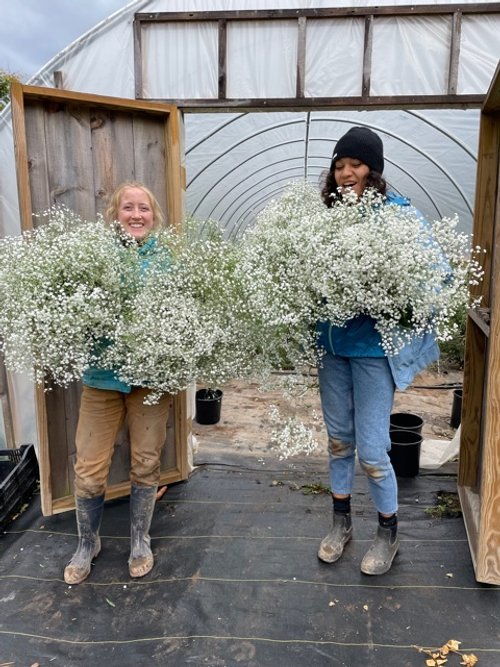growing baby's breath
We’ve tried growing perennial baby’s breath in our field plantings before. They produced a few airy stems per season, but never really took off for us. We’ve also tried the annual variety called ‘Covent Gardens.’ We grew that crop under cover, with horizontal netting support and still got a huge tangled mess of short stems that were largely broken and unusable by the time we sorted them out.
But last spring year we co-planted a number of our caterpillar tunnel rose bushes with hybrid gypsophila varieties…and…boom! They took off at the end of the summer and straight into the the fall. These plants are huge. Like many children of the 80s, I learned to associate baby’s breath with cheap, mundane floral design. But these seem so much fuller and more fluffy than anything I remember from my childhood. And baby’s breath has become trendy again in recent years. Now, designers are building full, fluffy clouds of it— huge hanging arrangements and giant ceremony installations.
A fresh harvest of baby’s breath headed for the drying in the studio
I see value in these plants for a number of reasons-
They are perennial, so a one time investment will reap rewards for us for years.
They are low maintenance, requiring little water.
They can be used fresh or dried.
As a cut flower, they hold up beautifully out of water. This makes them a smart choice for sustainable floral mechanics.
They seem to be pretty much pest and disease free— this makes baby’s breath great to grow as a species and great for use in co-planting next to more vulnerable plants, like roses.
An important note of caution: baby’s breath can spread and become invasive in many areas. It’s important to know if you can safely grow them in your area before planting them. We are growing particular hybrid cut flower varieties and we have chosen to contain our plants in our structures. We also use a tightly woven insect netting on these structures as part of our pest exclusion program for the roses. The fabric serves double duty to prevent the spread of seeds from the gypsophila. We also harvest our baby’s breath stems before they go to seed.
Baby’s breath co-planted with rose shrubs in one of our caterpillar tunnels
Our baby’s breath plants have over-wintered beautifully in our unheated tunnels and the plants are coming in huge this spring. As our business transitions towards a focus on more educational programs, we delight in plants that are more cost effective, require less labor, have a long vase life, and return reliably year after year. I’m sure you’ll be reading more about our perennial investments here soon!
As always, please share your questions and comments below. We’d love to hear from you and we’ll do our best to answer your questions.



